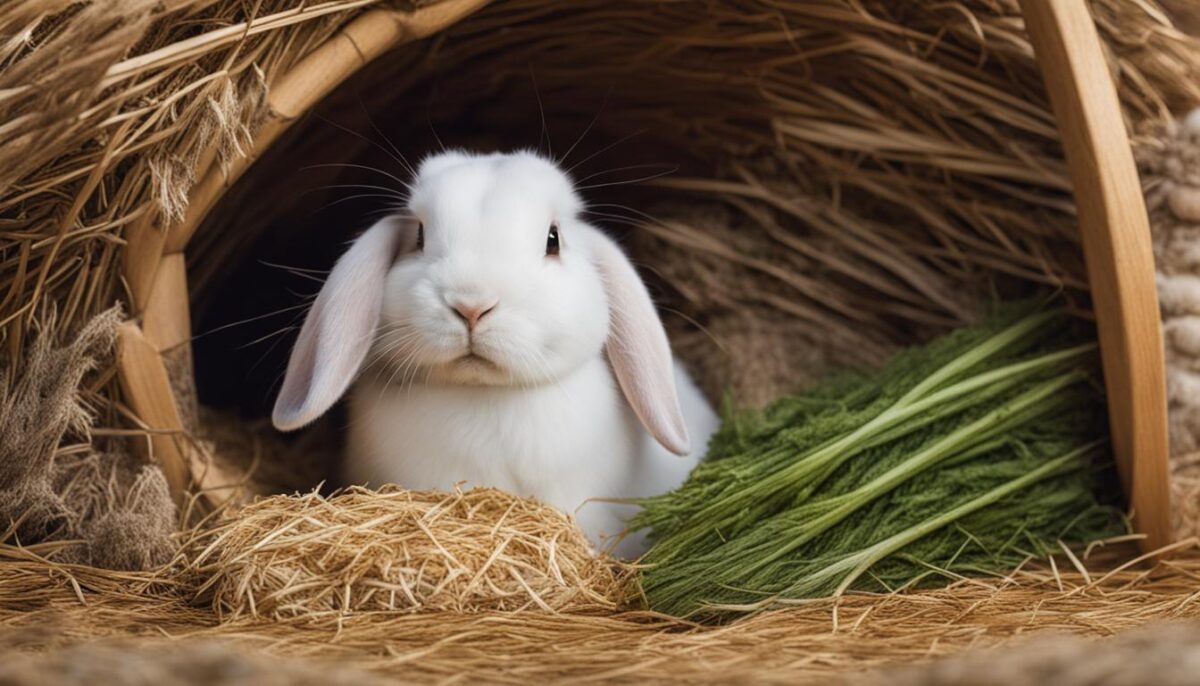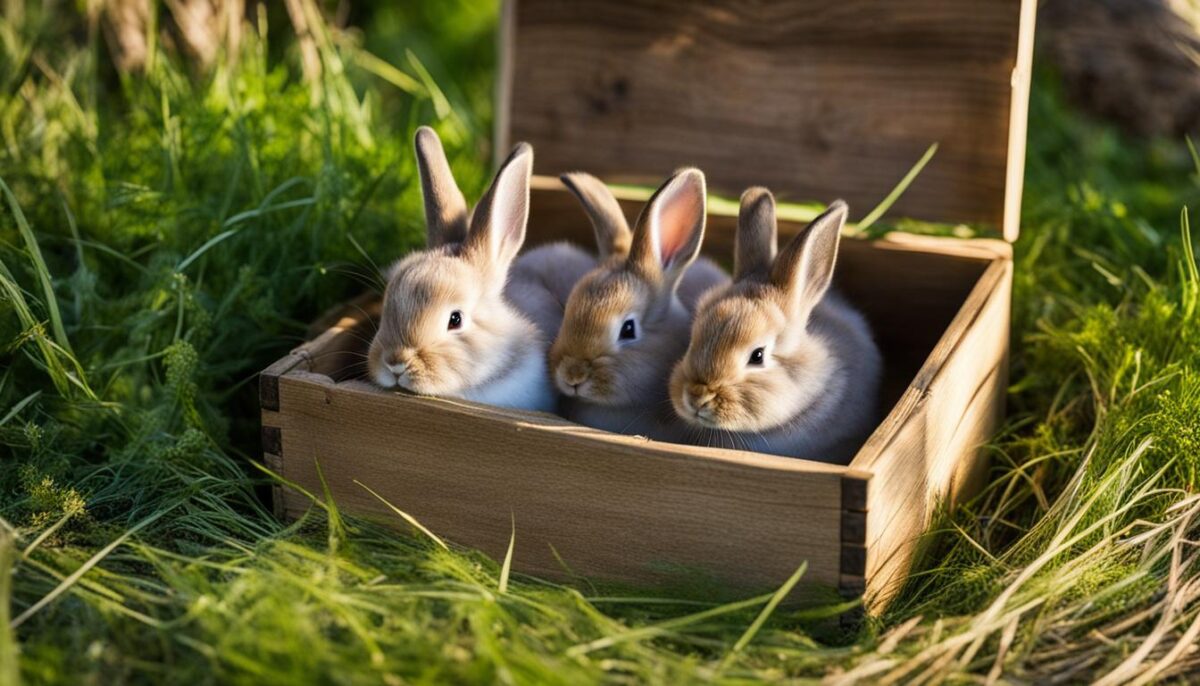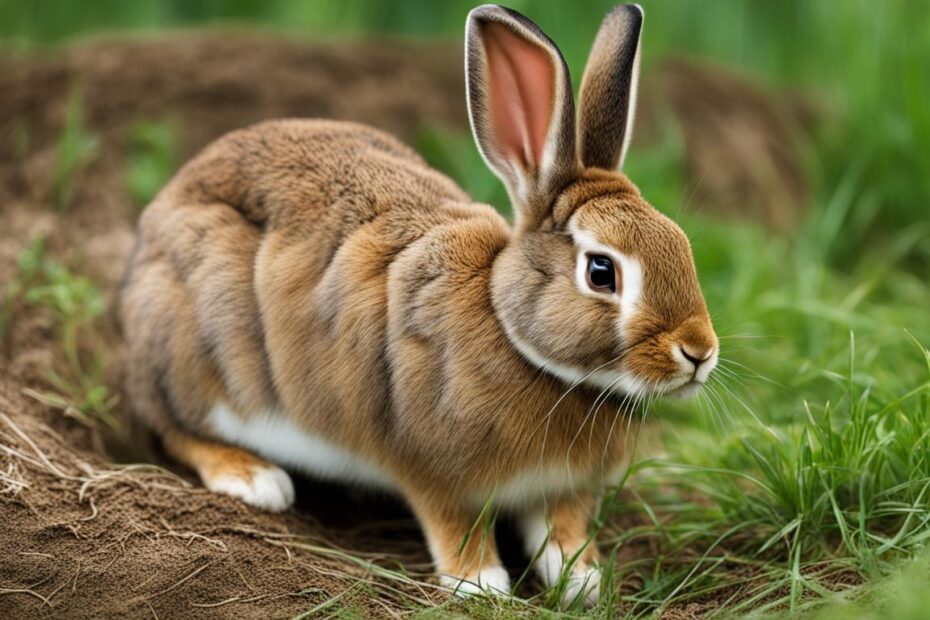Female rabbits can become pregnant as early as 12 weeks old and can continue to have babies up to the age of four years. Signs of a pregnant rabbit include nest building, fur pulling, and aggressive behavior. If you suspect your rabbit may be pregnant, it is important to be aware of the signs of labor to ensure a safe and healthy delivery.
Key Takeaways:
- Pregnant rabbits can exhibit signs of labor such as nest building, fur pulling, and aggressive behavior.
- It is recommended to seek confirmation from a veterinarian if you suspect your rabbit is pregnant.
- Understanding the signs of labor in rabbits is crucial for timely intervention and the well-being of the mother and her kits.
- Providing appropriate nutrition and a comfortable nesting area are essential during the pregnancy and labor period.
- Consulting with a vet is always recommended for confirmation and further guidance.
When Can Rabbits Mate?
Knowing when rabbits can mate is essential for responsible breeding and preventing unwanted pregnancies. The breeding age for rabbits varies depending on the breed and individual maturity, but generally, female rabbits can mate as early as 12 weeks old. It’s important to note that rabbits can conceive at any time of the year, so it’s crucial to keep unneutered bucks and does separate unless intentional breeding is desired.
Neutering Rabbits
Neutering is an important consideration for rabbit owners who do not wish to breed their pets. Neutering refers to the surgical removal of the rabbit’s reproductive organs, typically performed by a veterinarian. Neutering not only prevents unwanted pregnancies but also offers several health benefits for both male and female rabbits. It can help reduce the risk of certain cancers and behavioral issues related to mating instincts.
To determine the appropriate time for neutering, it is recommended to consult with a veterinarian. In general, rabbits can be neutered as early as four to six months of age. However, the timing may vary depending on the rabbit’s breed, size, and overall health. It’s important to discuss the procedure, potential risks, and recovery process with a knowledgeable veterinarian before making a decision.
| Benefits of Neutering: | Male Rabbits | Female Rabbits |
|---|---|---|
| Prevents unwanted pregnancies | Reduces aggression | Eliminates the risk of uterine cancer |
| Reduces territorial marking | Prevents testicular cancer | Reduces the risk of mammary tumors |
| Reduces spraying behavior | Helps manage hormonal aggression |
Neutering is a responsible choice for rabbit owners who want to prevent unwanted litters and provide a safer, healthier environment for their furry companions. Consult with a veterinarian to discuss the best options for your rabbit’s specific needs.
Rabbit Pregnancy Signs
Recognizing the signs of pregnancy in rabbits is crucial for understanding their reproductive health. By observing their behavior and physical changes, you can determine if a rabbit is pregnant and provide the necessary care. Some common signs of rabbit pregnancy include nest building, fur pulling, and changes in behavior.
One of the noticeable signs of a pregnant rabbit is nest building. Female rabbits will collect hay or straw and create a cozy nest in preparation for their babies. This instinctual behavior is an indication that they are preparing for the arrival of their offspring. Additionally, pregnant rabbits may engage in fur pulling, where they pluck their own fur to line the nest and provide warmth to the kits.
“Nest building and fur pulling are common signs of a pregnant rabbit. These behaviors demonstrate the mother’s natural instincts to create a safe and comfortable environment for her babies.”
Changes in behavior can also indicate a rabbit’s pregnancy. Pregnant rabbits may exhibit increased aggression or refuse physical contact. This protective behavior is a natural response to protect their growing offspring. However, it is important to note that these signs alone are not definitive proof of pregnancy. Consultation with a veterinarian is recommended to confirm pregnancy and receive further guidance on caring for your pregnant rabbit.
| Pregnancy Sign | Description |
|---|---|
| Nest Building | Female rabbits gather hay or straw to create a nest for their babies. |
| Fur Pulling | Rabbits pluck their own fur to line the nest and provide insulation for the kits. |
| Behavior Changes | Pregnant rabbits may display increased aggression or refuse physical contact. |
By being attentive to nest building, fur pulling, and changes in behavior, you can recognize the signs of a pregnant rabbit. These signs indicate that your rabbit may soon give birth to adorable kits. Remember to seek professional advice from a veterinarian to ensure the health and well-being of both the mother and her offspring. Providing a comfortable and nurturing environment during pregnancy is essential for a successful and stress-free delivery.
Preparing for the New Arrivals
During pregnancy, it is crucial to provide a pregnant rabbit with the proper nutrition and a comfortable nesting area. The mother rabbit’s well-being directly impacts the health of the kits and the success of the labor process. Here are some essential considerations to prepare for the new arrivals:
1. Nutrition for Pregnant Rabbits
The mother rabbit’s diet during pregnancy should consist of high-quality hay, fresh vegetables, and a small amount of alfalfa pellets. Dark leafy greens, such as kale and spinach, provide essential vitamins and minerals. It is important to gradually introduce new foods and monitor the rabbit’s digestive system for any adverse reactions. Providing plenty of clean water is also necessary for the pregnant rabbit’s hydration.
2. Creating a Comfortable Nesting Area
Rabbits have an instinct to create nests before giving birth. To facilitate this behavior, provide the mother rabbit with a suitable nesting box filled with hay or straw. The box should be spacious enough for the rabbit to comfortably move around but small enough to provide a sense of security. Placing the nesting box in a quiet and secluded area of the enclosure will help the rabbit feel safe and undisturbed during labor.
3. Monitoring Rabbit Nesting Behavior
Observing the mother rabbit’s nesting behavior can provide valuable insights into the progress of the pregnancy and impending labor. Look for signs of increased activity in constructing the nest, such as gathering and arranging hay or fur. The rabbit may also display protective behavior, such as growling or aggressive posturing. It is important to respect the mother rabbit’s need for privacy and avoid unnecessary disturbances in the days leading up to labor.

By ensuring the mother rabbit has a nutritious diet, a comfortable nesting area, and an undisturbed environment, you can help prepare for the new arrivals and support a successful labor. Remember to consult with a veterinarian for personalized guidance and to address any concerns related to the health and well-being of the pregnant rabbit.
Rabbit Labor
Understanding rabbit labor is crucial for the proper care and support of a pregnant rabbit. The gestation period in rabbits typically lasts between 31 and 33 days. When a doe gives birth, it is called kindling, and this usually occurs in the early morning hours. Unlike some other animals, the process of giving birth for rabbits is instinctive and rarely obstructed, making it a natural and straightforward process.
During labor, the doe may display signs of restlessness and discomfort. It’s essential to create a calm and quiet environment to minimize stress and ensure a smooth delivery. It is advisable to avoid disturbing the nest for the first few days after birth to allow the mother and kits to bond undisturbed.
In order to provide the best care during labor, it is recommended to observe the doe from a distance and offer support if necessary. However, intervention should be minimal, as the mother will instinctively take care of her litter. If there are concerns about the labor process or if the doe appears to be in distress, it is best to consult with a veterinarian for guidance and assistance.
Signs of Rabbit Labor
Recognizing the signs of labor in rabbits is important for anticipating and preparing for the arrival of the kits. Common signs include:
- Nest Building: The doe will create a cozy nest using hay or straw to provide a safe and warm environment for her offspring.
- Restlessness: The doe may exhibit restless behavior, such as digging or rearranging bedding, indicating that labor is imminent.
- Decreased Appetite: A decrease in the doe’s appetite is normal during labor as her focus shifts towards giving birth and caring for her kits.
- Nesting Behavior: The doe may display nesting behavior, such as pulling out fur from her body to line the nest and provide insulation for the kits.
By being aware of these signs, rabbit owners can be better prepared to support their doe during the labor process and ensure the health and well-being of both the mother and her kits.
Rabbit Litters
In this section, we will explore the fascinating world of rabbit litters and learn more about the number of kits in a litter and the nursing behavior of mother rabbits.
Rabbit Litter Size: A rabbit litter can contain up to 14 kits, although the average number is typically around six. It’s incredible to think that a single rabbit can give birth to so many offspring in one pregnancy!
Did you know? A rabbit’s ability to produce multiple offspring in a single litter is known as polytocous reproduction. This evolutionary adaptation allows rabbits to maximize their reproductive success.
Development of Kits: When kits are born, they are hairless, blind, and deaf. However, they start developing features rapidly. After just 10 days, their fur begins to grow, and their eyes and ears start to open. It’s truly amazing to witness the rapid growth and development of these adorable little creatures!
Maternal Care:
Mother rabbits, known as does, exhibit remarkable nursing behavior towards their kits. They typically nurse their babies twice a day, providing them with the essential nutrients they need for growth and development. This nursing period usually lasts for four to six weeks.
“The devotion and care that mother rabbits show to their offspring is truly remarkable. They create a warm and safe environment for their kits, ensuring their survival and well-being,” says Dr. Sarah Thompson, a veterinarian with expertise in small mammal care.
It is important to note that female rabbits can be re-impregnated shortly after giving birth. To avoid unwanted pregnancies, it is crucial to separate them from males and provide proper contraception measures, such as spaying or neutering.

Table: Comparison of Potential Rabbit Owners
| Criteria | Responsible Owner | Irresponsible Owner |
|---|---|---|
| Housing | Provides a spacious, secure, and appropriate living environment | Keeps rabbits in cramped or unsuitable cages |
| Nutrition | Offers a balanced diet of fresh vegetables, hay, and high-quality pellets | Feeds rabbits an inadequate or improper diet |
| Veterinary Care | Regularly takes rabbits to the vet for check-ups, vaccinations, and spaying/neutering | Neglects veterinary care, leading to potential health issues |
| Knowledge and Time Commitment | Has a good understanding of rabbit behavior, socialization, and dedicates time to care for them | Lacks knowledge about rabbits and does not invest time in their well-being |
It is our responsibility as caregivers to ensure that the rabbit kits find loving and attentive homes. By being diligent in the rehoming process, we can help establish a positive future for these adorable creatures.
Conclusion
The ability to recognize pregnant rabbit labor signs is crucial for the well-being of both the mother and the kits. As we have discussed, some common signs include nest building, fur pulling, aggressive behavior, and weight gain. By being aware of these indicators, rabbit owners can take timely action and ensure a safe and healthy birthing process.
During pregnancy, providing the mother rabbit with the proper nutrition is essential. A balanced diet consisting of dark leafy greens, alfalfa hay, and rabbit pellets will support her overall health and the growth of the kits. Additionally, creating a comfortable nesting area with a proper nest box and ensuring privacy for the doe will contribute to a stress-free labor.
As responsible rabbit owners, it is important to monitor the doe’s behavior closely during this time. Consulting with a veterinarian for confirmation of pregnancy and for further guidance is always recommended. They can provide specific advice tailored to your rabbit’s needs and ensure a smooth transition for both the mother and the kits.
In summary, being able to identify the signs of rabbit labor is a valuable skill for any rabbit owner. By understanding the behaviors and needs of a pregnant rabbit, we can provide the necessary care and support for a successful birth. Remember to consult with a veterinarian for professional guidance and enjoy the journey of witnessing new life entering the world.
FAQ
What are the signs of labor in pregnant rabbits?
Signs of labor in pregnant rabbits include nest building, fur pulling, and aggressive behavior.
When can rabbits mate?
Rabbits can mate as early as 12 weeks old and can conceive at any time of the year.
How can I recognize if my rabbit is pregnant?
Signs of pregnancy in rabbits include nest building using hay or straw, fur pulling to create a blanket for the babies, and increased aggression or refusal of physical contact.
How can I prepare for the arrival of rabbit babies?
To prepare for rabbit labor, provide the mother rabbit with plenty of clean water and nutritious food, including dark leafy greens, alfalfa hay, and rabbit pellets. Also, ensure she has a proper nest box and privacy.
What is the gestation period for rabbits?
The gestation period for rabbits is typically between 31 and 33 days.
How many kits can a rabbit have in a litter?
A rabbit litter can contain up to 14 kits, with six being the average number.
How long do rabbit kits nurse for?
Rabbit kits are usually fully weaned at four to six weeks old.
Should I separate the mother rabbit from the kits?
It is recommended to provide a separate area in the enclosure for the mother rabbit to get away from the kits and protect the nest from predators.
When can rabbit kits be rehomed?
Rabbit kits can leave their mother at around eight weeks old.


